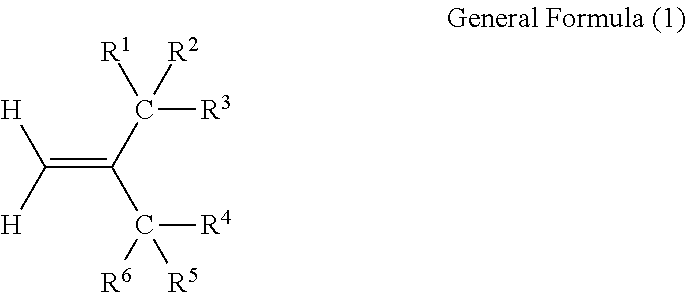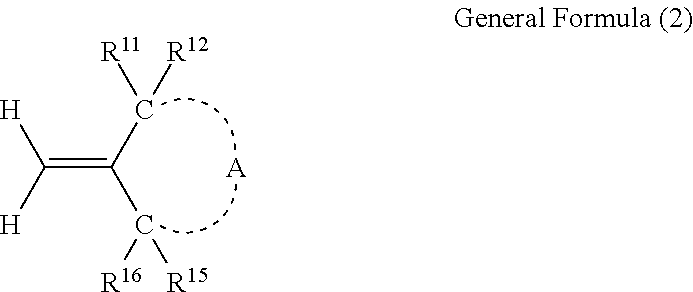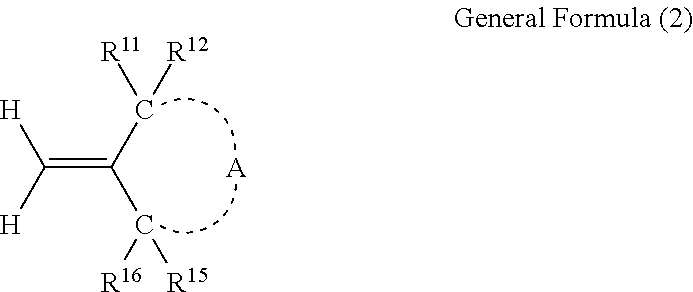Semi-cured product, cured product and method of manufacturing these, optical component, curable resin composition
a technology of thermoplastic resin and product, applied in the direction of optics, optical elements, instruments, etc., can solve the problems of thermoplastic resin having poor heat resistance, easy deformation by heat, defective optical elements molded from them, etc., and achieve the effect of increasing the heat resistance and good rate after molding
- Summary
- Abstract
- Description
- Claims
- Application Information
AI Technical Summary
Benefits of technology
Problems solved by technology
Method used
Image
Examples
example 1
Obtainment of Non-Conjugated Vinylidene Group-Containing Compound
[0179]A non-conjugated vinylidene group-containing compound B-1, Tokyo Chemical Industry's trade name β-Caryophyllene was used.
[0180]60 parts by mass of the above-mentioned polyfunctional (meth)acrylic monomer (Aa-1) (Shin-Nakamura Chemical Industry's trade name: A-DCP), 30 parts by mass of the above-mentioned monofunctional (meth)acrylic monomer (Ab-1) (Osaka Organic Chemical Industry's trade name: ADMA), 10 parts by mass of the above-mentioned non-conjugated vinylidene group-containing compound B-1 (Tokyo Chemical Industry's trade name: β-Caryophyllene), 0.1 parts by mass of the following photoradical polymerization initiator F-1 (BASF's Irgacure 184), 1 part by mass of the following thermal radical polymerization initiator F-3 (NOF's Perbutyl O), and 0.5 parts by mass of the following thermal radical polymerization initiator F-4 (NOF's Percumyl H) were mixed to prepare a curable resin composition of Example 1.
[0181]...
examples 2 to 25
, Comparative Examples 1 to 5
[0200]Curable resin compositions were prepared, for which the materials used were changed as in the following Table 1 and Table 2, and semi-cured products and cured products of Examples and Comparative Examples were produced and evaluated. The obtained results are shown in the following Table 1 and Table 2. The non-conjugated vinylidene group-containing compounds B-2, B-3, B-5 and B-8, and the polyfunctional (meth)acrylate monomers Aa-2 and Aa-10 were obtained according to the following methods.
B-2: Tokyo Chemical Industry's trade name (+)-Limonene
B-3: Sigma Aldrich Japan's trade name (+)-Longifolene
B-5: Sigma Aldrich Japan's trade name (+)-Aromadendrene
B-8: Sigma Aldrich Japan's trade name (−)-Alloisolongifolene
Aa-2: Shin-Nakamura Chemical Industry's trade name DCP
Aa-10: Daicel-Cytec's PETIA (pentaerythritol triacrylate)
[0201]The polymers having a non-conjugated vinyl group in the side chain thereof, E-1, E-2 and E-3 used in Examples 12 to 20 and 25 wer...
PUM
| Property | Measurement | Unit |
|---|---|---|
| frequency | aaaaa | aaaaa |
| viscosity | aaaaa | aaaaa |
| light transmittance | aaaaa | aaaaa |
Abstract
Description
Claims
Application Information
 Login to View More
Login to View More - R&D Engineer
- R&D Manager
- IP Professional
- Industry Leading Data Capabilities
- Powerful AI technology
- Patent DNA Extraction
Browse by: Latest US Patents, China's latest patents, Technical Efficacy Thesaurus, Application Domain, Technology Topic, Popular Technical Reports.
© 2024 PatSnap. All rights reserved.Legal|Privacy policy|Modern Slavery Act Transparency Statement|Sitemap|About US| Contact US: help@patsnap.com










